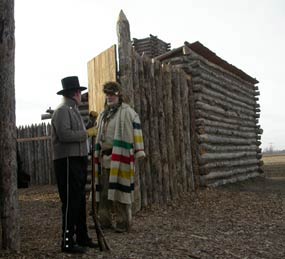 |
| NPS photo | | Reenactors stand outside a replica of Camp Dubois. |
 |
After the Corps of Discovery departed Camp Dubois on May 14, 1804, Sergeant Patrick Gass recorded his thoughts: “..in the evening we encamped on the north bank six miles up the river. Here we had leisure to reflect on our situation, and the nature of our engagements: and, as we had all entered this service as volunteers, to consider how far we stood pledged for the success of an expedition…”
Camp Dubois sat at the confluence of the Missouri and Mississippi rivers, near present day Hartford, Illinois. Between December 1804 and May 1805, Camp Dubois housed the men of the newly formed Corps of Discovery. During those months dedicated to final preparations for the long journey, these men brawled and drank and disobeyed. And yet as they prepared, the men began the slow process of becoming a corps, a unit.
guided this transformation. While wintered in St. Louis, securing provisions and consulting fur traders’ journals, Clark delegated and disciplined. Courts-martial and confinement were standards of military discipline. Hard work taught the men to rely on one another and prepared them for the long voyage. Turning mischief to skill, the men held shooting matches with local farmers and honed their marksmanship.
Camp Dubois proved to be the Expedition’s first test of cohesiveness. Living and working together prepared Corps members like Gass to face the trials the journey would bring. Still, on that spring morning in 1804, it was not without anticipation and trepidation that they “proceeded on under a jentle brease up the Missouri.”
More information about Camp Dubois is available in the following books and web sites.
Books
The Journals of the Lewis and Clark Expedition, vol. 2.
Edited by Gary E. Moulton and published by the University of Nebraska Press.
Web sites
Lewis and Clark State Historic Site
Enjoy Illinois: Illinois Bureau of Tourism Official Website with information about the Lewis and Clark Expedition in Illinois
Wood River Heritage Council, Camp Dubois with information about Camp Dubois then and now
| 





